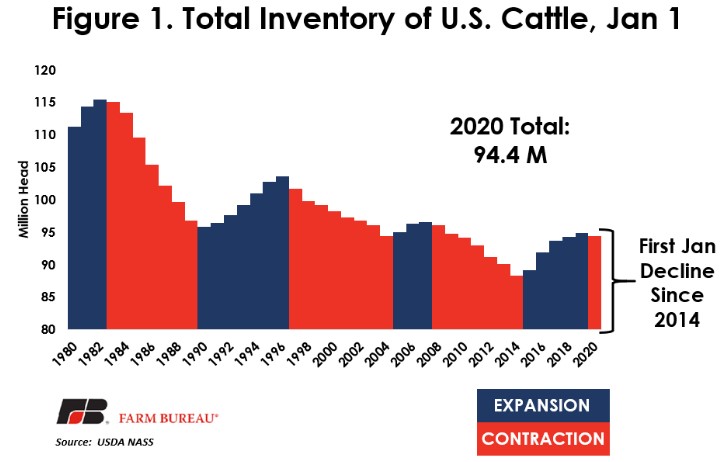On Friday, USDA released its biannual U.S. cattle inventory report showing U.S. cattle totals as of Jan. 1. The report provides inventory data for the nation’s cattle herd, including estimates of the number of breeding animals for beef and milk production, as well as the number of heifers being held for breeding herd replacement. This important report identifies beef and milk cow herd trends, helping the cattle industry evaluate the amount of product moving to market.
Cattle Inventory
As of Jan. 1, all cattle and calves in the U.S. totaled 94.413 million head, slightly below the 94.804 million head reported for Jan. 1, 2019. This marks the first year-over-year January decline in cattle numbers since 2014, the beginning of the current cattle cycle. From 2014 to 2020 the herd grew by more than 6.5 million head, an increase of approximately 7.4%. Higher prices in previous years largely drove the expansion of the herd. However, as these prices have come back down, the expansion of the herd has appeared to level off. Moving forward, some in the industry are calling for a more moderated herd decline in the next phase of this cycle than has been seen in previous cycles.

All cows and heifers that have calved totaled 40.651 million head, an approximately 1% decline from 41.044 million head in 2019. This decline is mostly reflected in a drawdown in beef cows rather than dairy cows, with beef cows declining almost 375,000 head compared to a nearly 20,000-head decline in dairy cows. Figure 2 shows the relationship between dairy and beef cows reported over time in the January report. When comparing the ratio of beef to dairy cows, the variation is largely driven by changes in the beef cow numbers as producers expand or contract in the cattle cycle. Over the past two decades, the number of dairy cows reported in the January report has remained relatively stable, especially when compared to the number of beef cows.
Click here to see more...